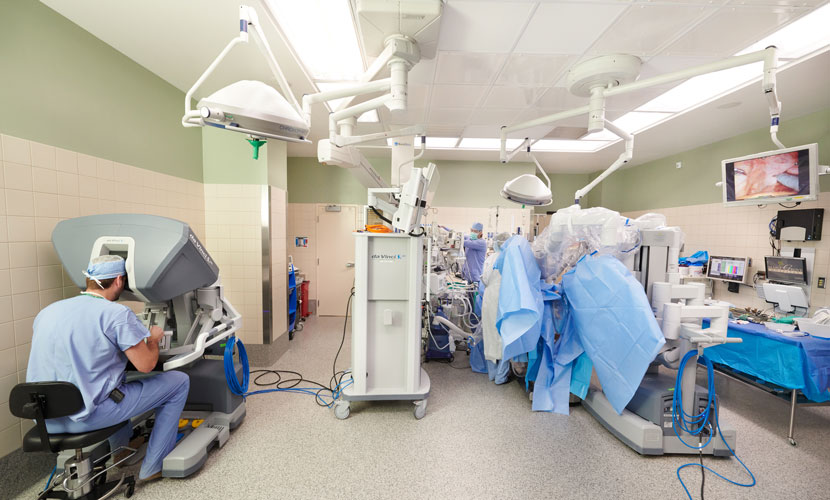Contributor: Matthew Palmer, D.O., an OB/Gyn physician with Oakdale Obstetrics and Gynecology in Maple Grove, MN who performs surgery at Maple Grove Hospital
Monthly cramps are uncomfortable, but if you’re feeling intense pain right before and during your periods, it may be a symptom of an underlying condition.
Endometriosis is a relatively common chronic gynecologic disorder that usually shows symptoms of chronic pelvic pain or infertility. The disease most commonly effects women of childbearing age – the average age at time of diagnosis is 28 – but can begin in the early teenage years, or as soon as menses begin.
The endometrium is the cellular lining of a woman’s uterus that builds and sheds cyclically each month during a woman’s normal menstrual cycle. When endometriosis develops these lining cells migrate out of the uterus and begin to implant themselves onto other pelvic and abdominal structures, such as the ovaries, pelvic sidewalls, bladder, bowels and even upper abdominal structures such as the diaphragm.
While not cancerous, these extra-uterine growths of tissue can cause chronic pain, severely painful and heavy menstrual periods, painful sexual intercourse, painful bowel movements and bladder pain. Additionally, endometriosis patients may complain of gastrointestinal distress, bloating, back and leg pain, and may have problems with infertility. It should also be noted that some women with endometriosis don’t have any symptoms.
Risk factors, Diagnosis and Treatment
Your risk for endometriosis increases seven- to ten-fold with family history of the disease in a first-degree relative such as your mother or sister. There are no known measures that you can take to prevent endometriosis from developing.
The diagnosis of endometriosis is based on a number of factors. Generally speaking, the disease cannot be formally diagnosed without surgical visualization and biopsy of the tissue affected by endometriosis.
Some indicators, such as ultrasound findings of an ovarian cyst or pelvic organ immobility, can help support the diagnosis. A physical exam with bimanual pelvic exam as well as a detailed history including personal and family history will help determine if further evaluation with a laparoscopy is required.
Treatment of endometriosis can be both medical and surgical. Medical management of endometriosis involves hormonal suppression of endometriosis with oral contraceptives and medications. The aim of medical management is to reduce pain associated with endometriosis. These therapies can be effective but symptoms usually reoccur shortly after the therapy is discontinued.
Surgical management of endometriosis is largely focused on the destruction or removal of all visible endometriosis lesions. Surgical cauterization or ablation involves superficial destruction of the lesion without exploration of the underlying tissue. Evidence suggests that this type of therapy is inadequate, with most patients having their pain return in less than a year after having this non-excisional surgery.
True excisional surgery (with confirmation of visual diagnosis by a pathologist) is much more effective in alleviating pain due to endometriosis and in preventing recurrence of the disease.
Advanced, Minimally Invasive Surgery
If your doctor suggests surgery, there are two main options: open surgery through one large incision (cut); and minimally invasive (laparoscopic) surgery that uses a few small incisions.
Advanced laparoscopic surgical technology using the da Vinci® System, a robotic-assisted surgical device, gives surgeons a 3D, high-definition view inside your body, along with greater precision and control. In fact, many surgeons say they can detect diseases more accurately than they were able to with a traditional laparoscope.
With recent advances in minimally invasive surgery and surgical technology, the management of endometriosis is becoming better than ever before. If you are experiencing the symptoms of endometriosis, seek advice from medical professionals who are familiar with management of the disease. Even with the help of robotic-assisted surgical technology, it is the skill and experience of the surgeon that is most important for a successful outcome.
Both Maple Grove Hospital and Robbinsdale Hospital are equipped with the da Vinci Surgical System and specially trained teams to perform minimally invasive, robotic procedures. Our professionals use advanced laparoscopic tools to diagnose endometriosis and remove growths that reduce your symptoms, including pain or abnormal bleeding, and potentially increase your chances of conceiving.

Learn more about obstetrics and gynecological surgery here or by calling 763-581-1000.


